(File under non-tech)
I had a few scanned pictures from my REC days, mostly ECE 97 guys, on my hard-drive. Thought there might be people who'd like to see 'em, so here goes:
PS: You are invited to identify yourselves in comments to the pics :)
My ramblings especially on technology, telecoms, mobile, media, IT and innovation.
Sunday, September 23, 2007
Saturday, September 22, 2007
Jan Shatabdi Trivandrum Ernakulam - the invisible emergency hammer.

Train journeys are seldom uneventful. Yesterday, Jayadev and I went on a one-day business trip to Ernakulam (Kochi) and back to Trivandrum (Thiruvananthapuram). This was my first trip on the Jan Shatabdi Express (the link says how these trains came about). Though conceived as a 'cleaner', faster and slightly costlier service, it is does not even come close to what would internationally be considered fast and clean. A google search also drew out this undated document lamenting its low occupancy rate (? - our train was pretty full; the doc seems to have been written in 2003)
1. Pretty fast with just a few stops and pretty comfy luxury bus kinda push back seats.

2. GPS / GSM (?) based station display which shows ETA at the next stop, the time we passed last waypoint etc.
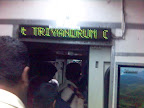
And now the bad things:
1. Whoever designed the air-conditioning system, gave no thought to the noise it made! It made a constant shrill high pitched tone almost throughout the journey! Unfortunately, no one else seemed to share my sensitivity towards this sound - they seemed happily unaware of the sound that was driving me crazy.
2. Tea / coffee / snacks. Although the entire journey hardly last a quarter of a day - it does make one hungry. I was pleasantly surprised to find Nescafe coffee vending machines and microwave ovens inside the compartments (Now that sounds like a first inside indian railways). However, I was told that these had just been there for a few weeks and might take months to get functional. I sure hope railways can make it operational asap.
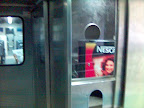
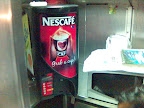
3. Now for the (dangerously bad) icing on the spoilt cake ;) This is something that we Indians are pretty good at - being terribly unprepared for emergencies. The pictures are self explanatory. However, for those who cannot see the writing on the image clearly, here's the text - "HAMMER FOR BREAKING THE WINDOW GLASS DURING EMERGENCY". The only problem is - there is no hammer inside the beautifully sealed enclosure (or it is of the invisible kind). A quick glance revealed that even the next compartment had a non-existent emergency hammer.
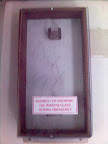
Now, I do not know for sure how much difference that hammer might make in an emergency, but I sure do hope and pray that no-one gets into such a situation!
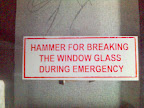
Friday, September 14, 2007
Mobile handsets as gaming devices. Part III
(...Continued from Part II)
The following graphic depicts a rough time-line. Most of the handsets like the Motorola T720 and the Nokia 7650 are now extinct.

A notable and notorious handset as far as mobile gaming is concerned was the N-Gage and the N-Gage QD from the Nokia stable. Though visionary in its purpose, it failed in its execution at being a mass market gaming device which could also make phone calls. The take-away from its life was the fact that until the technology so matures, mobile phones are not a hard-core gamer's first port of call. They will always have their PS3s for that.
However, what is notable is the progress made in handset technology over these few years (you may note that a major part of this whole 'history' I am talking about has unraveled in just about half a decade! The growth IS that frantic and this means that the cool phone that I carry today will be tomorrow's junk. This rapid evolution can be tracked using the following attributes which are relevant from a developer's perspective.
a. Screen resolution
The following representation should give you a good idea:
...2001...
...2002...
...2004...
...2005...
...2007...
b. Keypad and its layout
Undoubtedly the most used and abused parts of most erstwhile digital devices. More so for phones used as gaming devices.
......2001...
Number keys only.
Other keys did not exist except for make / break call ones.
Even if other keys existed, their use inside apps was undefined and unintended.
...2002...
Standard layouts.
Soft-keys defined.
4-way simple joysticks incorporated and used in menus as well as simple games.
...2003...
Additional game specific keys prominent.
...2005...
Six+ way joysticks.
Simultaneous multiple keypress detection.
....
Other innovations in human interface including screen-touch and camera motion detection.
c. Processing power
...2001...
Very slow, inefficient processors, primarily intended to feed text only screens and very simple computational needs.
...2003...
Playable frame-rates for arcade style games. Reasonable number crunching.
...2004...
Good frame-rates, even 3D gets introduced, advanced screen rendering algorithms.
.....
The lines between personal computers and personal mobile phones is blurring further and further. Some devices as capable as earlier PCs and some like the iPhone carving a niche for the way in which the UI and power has been designed to give a superior user interface.
d. Memory
All the graphics, sound effects and rendering code need space - the more the better. More space translates into a better ability to pack in richer textures, detailed sprites and backgrounds with a good color-depth and range. Also, games gobble a good amount of working memory - the stack and the heap to give a better gaming experience. There is a lot of data associated with any game instance and these must be buffered for quick access. In simple terms abundant heap and stack space translates into a smoother and richer game-play.
...2001...
32 to 64KB jar size
200KB heap
...2004....
200KB jar size
512KB heap
...
Jar size in Mega Bytes
Introduction of Virtual memory...?
This pretty much sums up the evolutionary pattern being followed by mobile handsets. I'm sure as technology progresses, these parameters will be redundant - but until then and even beyond, they're welcome to stay on my journal ;).
In the next piece I intend to list out a few notable games that can be called milestones in the handsets' journey of evolution. Till then - adios!
The following graphic depicts a rough time-line. Most of the handsets like the Motorola T720 and the Nokia 7650 are now extinct.

A notable and notorious handset as far as mobile gaming is concerned was the N-Gage and the N-Gage QD from the Nokia stable. Though visionary in its purpose, it failed in its execution at being a mass market gaming device which could also make phone calls. The take-away from its life was the fact that until the technology so matures, mobile phones are not a hard-core gamer's first port of call. They will always have their PS3s for that.
However, what is notable is the progress made in handset technology over these few years (you may note that a major part of this whole 'history' I am talking about has unraveled in just about half a decade! The growth IS that frantic and this means that the cool phone that I carry today will be tomorrow's junk. This rapid evolution can be tracked using the following attributes which are relevant from a developer's perspective.
a. Screen resolution
The following representation should give you a good idea:
...2001...
100 x 80
...2002...
128 x 128
...2004...
176 x 220
...2005...
240 x 320
...2007...
480 x 320, 160 dpi - The iPhone
b. Keypad and its layout
Undoubtedly the most used and abused parts of most erstwhile digital devices. More so for phones used as gaming devices.
......2001...
Number keys only.
Other keys did not exist except for make / break call ones.
Even if other keys existed, their use inside apps was undefined and unintended.
...2002...
Standard layouts.
Soft-keys defined.
4-way simple joysticks incorporated and used in menus as well as simple games.
...2003...
Additional game specific keys prominent.
...2005...
Six+ way joysticks.
Simultaneous multiple keypress detection.
....
Other innovations in human interface including screen-touch and camera motion detection.
c. Processing power
...2001...
Very slow, inefficient processors, primarily intended to feed text only screens and very simple computational needs.
...2003...
Playable frame-rates for arcade style games. Reasonable number crunching.
...2004...
Good frame-rates, even 3D gets introduced, advanced screen rendering algorithms.
.....
The lines between personal computers and personal mobile phones is blurring further and further. Some devices as capable as earlier PCs and some like the iPhone carving a niche for the way in which the UI and power has been designed to give a superior user interface.
d. Memory
All the graphics, sound effects and rendering code need space - the more the better. More space translates into a better ability to pack in richer textures, detailed sprites and backgrounds with a good color-depth and range. Also, games gobble a good amount of working memory - the stack and the heap to give a better gaming experience. There is a lot of data associated with any game instance and these must be buffered for quick access. In simple terms abundant heap and stack space translates into a smoother and richer game-play.
...2001...
32 to 64KB jar size
200KB heap
...2004....
200KB jar size
512KB heap
...
Jar size in Mega Bytes
Introduction of Virtual memory...?
This pretty much sums up the evolutionary pattern being followed by mobile handsets. I'm sure as technology progresses, these parameters will be redundant - but until then and even beyond, they're welcome to stay on my journal ;).
In the next piece I intend to list out a few notable games that can be called milestones in the handsets' journey of evolution. Till then - adios!
Labels:
cellphone,
history,
j2me,
java,
javame,
mobile game,
motorola,
motorola t720,
n-gage,
n-game qd,
nokia,
nokia 7650,
phone,
processing,
screen size,
siemens cx65,
sonyericsson k700
Sunday, September 02, 2007
Mobile handsets as gaming devices. Part II
(...Continued from part I)
Around the same time, Qualcomm launched BREW - a rival platform for CDMA phones running on its chip-sets. While J2ME had a mass following due to a high number of Java developers available, BREW had a smaller following.
Many would argue that despite the ease of coding and huge developer network, BREW had an edge over Java for the reason that it was built as a product with a monetization mechanism built it, while the engineers at Sun Microsystems were more intent on building a 'standards platform'. That apart from the fact that BREW code works closest to the machine and hence has potentially better performance.
However, considering its reach, J2ME (now known as JavaME) which is available on almost all GSM phones and a few CDMA phones is unrivaled.
The following is the first Java enabled phone from Motorola - the i3000
 Year 2001. Motorola i3000. Screen 110 x 110 px. Black and White
Year 2001. Motorola i3000. Screen 110 x 110 px. Black and White
Around the same time, Qualcomm launched BREW - a rival platform for CDMA phones running on its chip-sets. While J2ME had a mass following due to a high number of Java developers available, BREW had a smaller following.
Many would argue that despite the ease of coding and huge developer network, BREW had an edge over Java for the reason that it was built as a product with a monetization mechanism built it, while the engineers at Sun Microsystems were more intent on building a 'standards platform'. That apart from the fact that BREW code works closest to the machine and hence has potentially better performance.
However, considering its reach, J2ME (now known as JavaME) which is available on almost all GSM phones and a few CDMA phones is unrivaled.
The following is the first Java enabled phone from Motorola - the i3000
 Year 2001. Motorola i3000. Screen 110 x 110 px. Black and White
Year 2001. Motorola i3000. Screen 110 x 110 px. Black and WhiteSiemens too launched its first Java handset the same year- the SL45. For many J2ME enthusiasts, the Siemens SL45 was an introduction of sorts.
Not to be left behind, Nokia too came out with its classic Java enabled phone. The rugged and handy Nokia 3410 candybar was perhaps the first mass market J2ME MIDP 1.0 device.
The 'other' platforms
It was not as if there were no other mobile development platforms around, infact there were a handful of them, some very good ones too - alas, not all are as successful as J2ME and BREW.
The most notable among the 'other' platforms was Mophun. Mophun was a revolution of sorts. Initially built for the Sony Ericsson T300 (We called it the soap-box phone ;) ), it was the first arcade level mobile gaming platform with a freely download-able SDK. The T300 was one of the first handsets to have an 100 x 80 color screen, sound effects support and a joystick. It even supported an external camera ;)
Infusio meanwhile developed another Java based platform name ex-en. It featured on a few Sagem, Philips, Toshibas and its likes.
Another notable platform was Do-ja. Again Java based (J2ME based to be more specific) with the exception of having a proprietary Profile originally built for the Japanese telcos.
The year 2002 and beyond witnessed mobile technologies literally leapfrogging. The screens kept getting better, the processor got faster and memory was bigger. The mobile world as we know it can be called the post 2002 era which we will explore in the next article.
(To be continued ...)
Not to be left behind, Nokia too came out with its classic Java enabled phone. The rugged and handy Nokia 3410 candybar was perhaps the first mass market J2ME MIDP 1.0 device.
The 'other' platforms
It was not as if there were no other mobile development platforms around, infact there were a handful of them, some very good ones too - alas, not all are as successful as J2ME and BREW.
The most notable among the 'other' platforms was Mophun. Mophun was a revolution of sorts. Initially built for the Sony Ericsson T300 (We called it the soap-box phone ;) ), it was the first arcade level mobile gaming platform with a freely download-able SDK. The T300 was one of the first handsets to have an 100 x 80 color screen, sound effects support and a joystick. It even supported an external camera ;)
Infusio meanwhile developed another Java based platform name ex-en. It featured on a few Sagem, Philips, Toshibas and its likes.
Another notable platform was Do-ja. Again Java based (J2ME based to be more specific) with the exception of having a proprietary Profile originally built for the Japanese telcos.
The year 2002 and beyond witnessed mobile technologies literally leapfrogging. The screens kept getting better, the processor got faster and memory was bigger. The mobile world as we know it can be called the post 2002 era which we will explore in the next article.
(To be continued ...)
Saturday, September 01, 2007
Mobile handsets as gaming devices. Part I
The humble mobile phone has come a long way. There was a time when this device was available only to the elite few, looked like a brick and cost a fortune to have and to keep. Heres how it all started. Though many wireless devices did exist before this brick, it holds the distinction of being the worlds first 'cellphone'.
Nokia (which started in 1865 as a wood pulp mill!) debuted its first GSM mobile phone only in 1992 with Nokia 1011 (though it too had made the first transportable phone in 1984)
Mobile phones were pretty serious business till some geek at Nokia decided to add some fun to it and along came Nokia 6110 with Snake on it!
Nokia's Snake is considered the 'pioneer' in mobile gaming.
 The enormous interest on this mobile game, even among the typical 'business' folk is legendary, with people vying with each other to break the high score record. For a few years, games such as Snake were production-embedded on handsets.
The enormous interest on this mobile game, even among the typical 'business' folk is legendary, with people vying with each other to break the high score record. For a few years, games such as Snake were production-embedded on handsets.
All that changed in 2000-2001, with the Java platform claiming a new playground. (... To be continued in part II)
Nokia (which started in 1865 as a wood pulp mill!) debuted its first GSM mobile phone only in 1992 with Nokia 1011 (though it too had made the first transportable phone in 1984)
Mobile phones were pretty serious business till some geek at Nokia decided to add some fun to it and along came Nokia 6110 with Snake on it!
Nokia's Snake is considered the 'pioneer' in mobile gaming.
 The enormous interest on this mobile game, even among the typical 'business' folk is legendary, with people vying with each other to break the high score record. For a few years, games such as Snake were production-embedded on handsets.
The enormous interest on this mobile game, even among the typical 'business' folk is legendary, with people vying with each other to break the high score record. For a few years, games such as Snake were production-embedded on handsets.All that changed in 2000-2001, with the Java platform claiming a new playground. (... To be continued in part II)
Subscribe to:
Posts (Atom)





